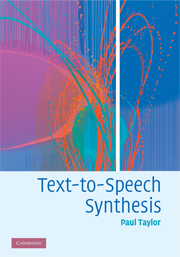Book contents
- Frontmatter
- Contents
- Foreword
- Preface
- 1 Introduction
- 2 Communication and language
- 3 The text-to-speech problem
- 4 Text segmentation and organisation
- 5 Text decoding: finding the words from the text
- 6 Prosody prediction from text
- 7 Phonetics and phonology
- 8 Pronunciation
- 9 Synthesis of prosody
- 10 Signals and filters
- 11 Acoustic models of speech production
- 12 Analysis of speech signals
- 13 Synthesis techniques based on vocal-tract models
- 14 Synthesis by concatenation and signal-processing modification
- 15 Hidden-Markov-model synthesis
- 16 Unit-selection synthesis
- 17 Further issues
- 18 Conclusion
- Appendix A Probability
- Appendix B Phone definitions
- References
- Index
5 - Text decoding: finding the words from the text
Published online by Cambridge University Press: 25 January 2011
- Frontmatter
- Contents
- Foreword
- Preface
- 1 Introduction
- 2 Communication and language
- 3 The text-to-speech problem
- 4 Text segmentation and organisation
- 5 Text decoding: finding the words from the text
- 6 Prosody prediction from text
- 7 Phonetics and phonology
- 8 Pronunciation
- 9 Synthesis of prosody
- 10 Signals and filters
- 11 Acoustic models of speech production
- 12 Analysis of speech signals
- 13 Synthesis techniques based on vocal-tract models
- 14 Synthesis by concatenation and signal-processing modification
- 15 Hidden-Markov-model synthesis
- 16 Unit-selection synthesis
- 17 Further issues
- 18 Conclusion
- Appendix A Probability
- Appendix B Phone definitions
- References
- Index
Summary
Overview of text decoding
The task of text decoding is to take a tokenised sentence and determine the best sequence of words. In many situations this is a classical disambiguation problem: there is one, and only one, correct sequence of words that gave rise to the text, and it is our job to determine this. In other situations, especially where we are dealing with non-natural-language text such as numbers and dates and so on, there may be a few different acceptable word sequences.
So, in general, text decoding in TTS is a process of resolving ambiguity. The ambiguity arises because two or more underlying forms share the same surface form, and, given the surface form (i.e. the writing), we need to find which of the underlying forms is the correct one. There are many types of linguistic ambiguity, including word identity, grammatical and semantic, but in TTS we need only concentrate on the type of ambiguity which affects the actual sound produced. So, while there are two words that share the orthographic form bank, they both sound the same, so we can ignore this type of ambiguity for TTS purposes. Tokens such as record can be pronounced in two different ways, so this is the type of ambiguity we need to resolve.
In this chapter, we concentrate on resolving ambiguity relating to the verbal component of language.
- Type
- Chapter
- Information
- Text-to-Speech Synthesis , pp. 78 - 110Publisher: Cambridge University PressPrint publication year: 2009



